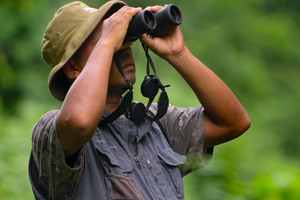Illustration of a bald-faced Vanzolini Saki. Marsh, 2014
Scientists have rediscovered a species of monkey in the Brazilian Amazon not seen alive since 1936, according to reporting by Mongabay.
The species, the bald-faced Vanzolini saki, was first discovered along the Rio Eiru more than 80 years ago by Alfonzo Olalla, an Ecuadorian naturalist. But scientists had found no other living evidence of the monkey since then. Earlier this year, a team of seven primatologists, led by Laura Marsh of the Global Conservation Institute, began a three-month expedition aboard a boat through the Upper Jurua River and its tributaries to search for the missing monkey and survey other wildlife in the remote region of Brazil.
The researchers first saw the species, which has a long fluffy tail and golden fur on its chest, legs, and arms, just four days into their survey trip. According to Mongabay, “over the next three months, the expedition found the monkeys distributed along the entirety of the surveyed areas of the southern tributaries of the Jurua in Amazonas state.”
But scientists warn that the newly rediscovered saki population lives dangerously close to Brazil’s “arc of deforestation.” The area, which borders the BR-364, a paved highway, is the scene of intense logging, agriculture, and ranching activities that could jeopardize the monkey’s habitat.



